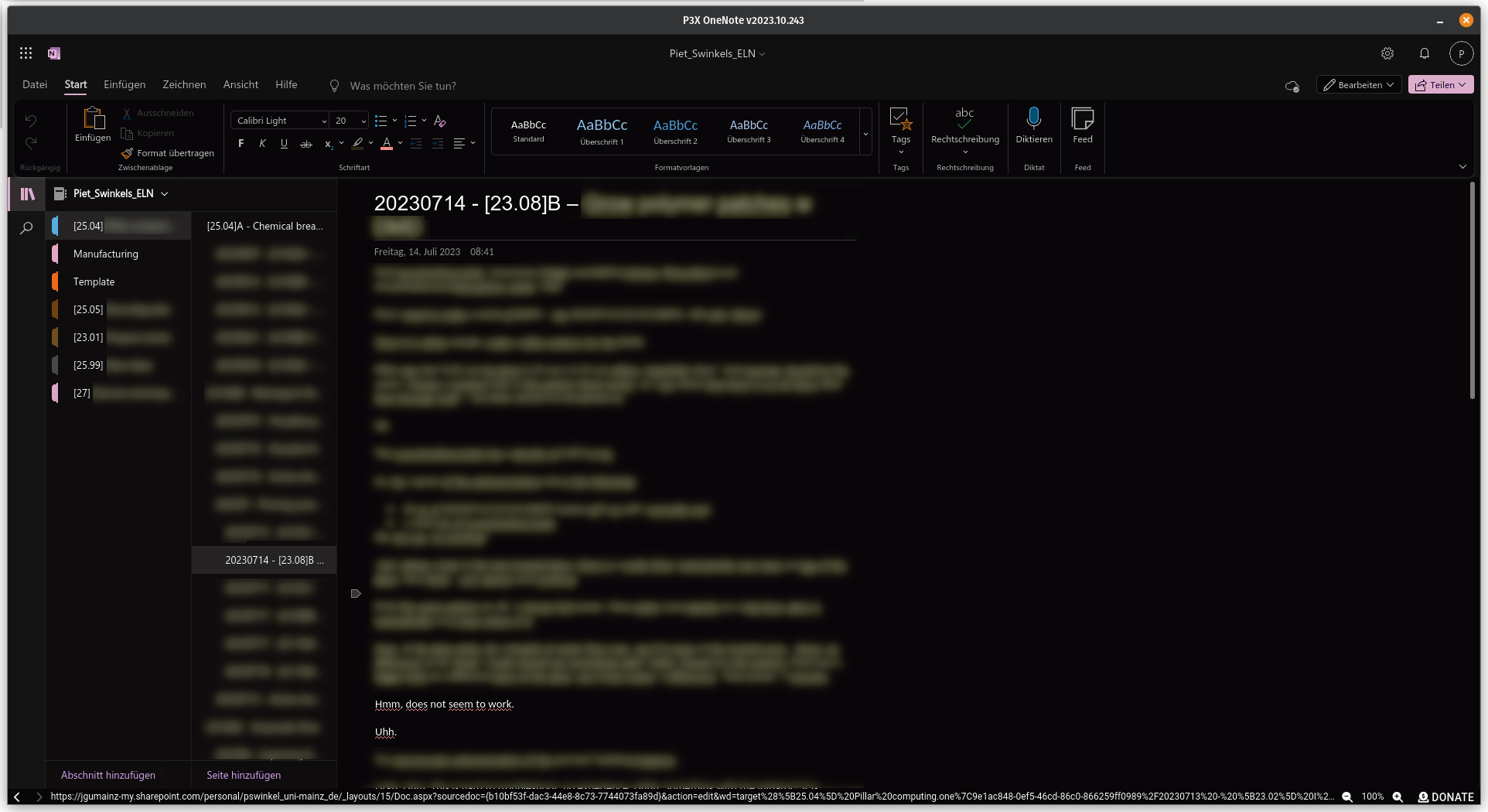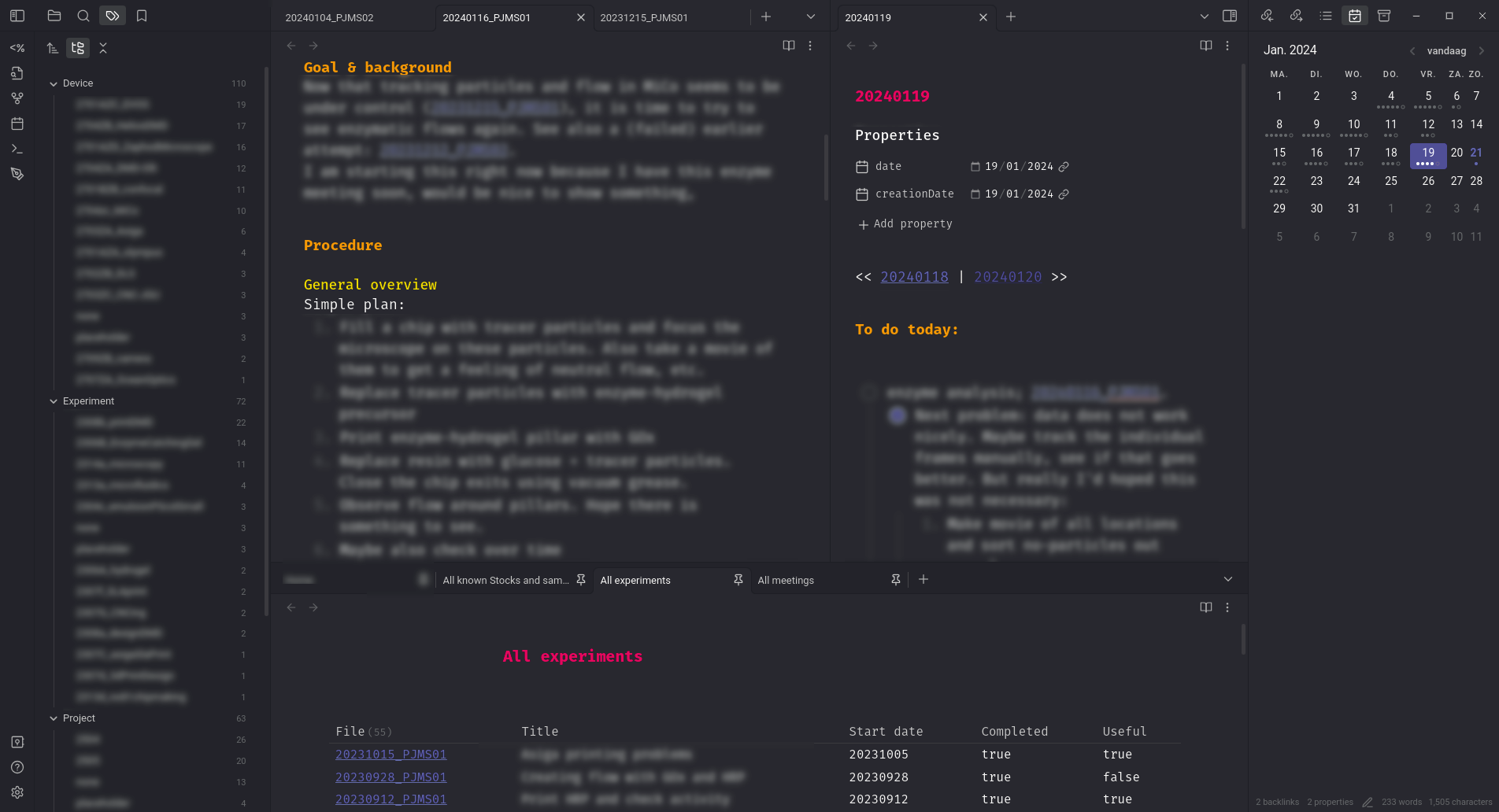Table of Contents
Why you should use an Electronic Lab Notebook, and Why I Chose Obsidian
In the beginning there was the physical book. The first half of my PhD, I wrote what I did in that physical notebooks. But, as the world is moving to more transparent science, Electronic Lab Notebooks (ELNs) are becoming the norm. After some struggling in OneNote, I have now settled for Obsidian.
Why an Electronic Lab Notebook
When I started my postdoc in the group of Andreas Walther, it became clear that in this lab, I needed to switch away from my trusty old notebooks and move to a digital format. Annoying at first, but probably a good development in the bigger picture. After all, science is moving more and more toward using electronic lab journals, and there are good reasons. Digital files are hard to simply loose, it is (much) easier to share data and protocols, and it is easier to just look for stuff. Anecdotally, I have spent multiple hours leafing trough nine (!) physical notebooks in the hope of finding a specific, poorly indexed experiment I half-remembered. On top of that, it is in the interest of open science that lab notebooks are easily published: instead of a polished protocol in a paper, it would be good to read what actually happened.
Of course there are fundamental downsides, which people barely ever discuss. Just to name a few:
- Sometimes, an electronic notebook is simply annoying in practice, especially in some lab-heavy fields. You want to put gloves on and off to make notes 20 times in a row to make some tiny note? Or take your laptop into a contaminated laboratory? Probably not. In a physical book this is not needed, just having a single contaminated pen solves the problem.
- Another problem is that it may stop people writing down their mistakes - even if they are important. Even if it is probably silly, and no-one would really care, scientists are only human, and feel unhappy sharing silly mistakes with the world. There is a real danger that ELNs cause people to keep a separate, “personal” lab notebook, and then write a more formal, censured version digitally.
- Files on a computer are not forever, unless properly back-upped. A paper notebook will (probably) not disappear randomly, but almost everyone has had a computer crash in their lives. And so, ELNs need to backup regularly, which can be annoying. Especially when software always requires internet to function, which is a stupid design decision which I've encountered before.
But all-in-all, I think it is a good move to make the switch to an electronic lab notebook.
What Does a Lab Notebooks Need to do?
Before we can decide what electronic lab notebook we want to use, we first need to decide on our requirements. I think the main and most important part is uncontroversial:
Planning and describing experiments should be frictionless and simple, and retrieving them later should be equally effortless.
But a lab notebook needs to be more than that. For me to actually switch away from paper, it needs to be able to do a bunch more:
Features
- The notebook should hold some sort of database with all samples and stocks I use in different experiments, so I can refer back to those.
- The journal should hold random notes, meeting notes, to-do lists, etc. etc..
- It should be easy to link media and data to an experiment, preferably with videos and images directly viewable.
- Also work in that one corner of the lab without internet - so no 'cloud-only' solution or something like that.
Convenience
- It should be possible to link to different experiments from within an experimental note.
- The journal should be easy and fast to use.
- I must be able to edit the notebook from different devices at the same time, without getting weird syncing errors and the like.
Flexible and open
- The electronic lab journal should not enforce stiff rules on what an experiment should look like, or what I can add to it, this wil really annoy me in the long term.
- is preferably open source, or failing that, at least keeps data in a open way. This way, even if the software stops working (because you stop paying, or because you leave the lab), you can extract the contents of the notebook and start over elsewhere.
- is aimed at an individual, and not a large lab. Because I am not outfitting a lab, I am outfitting myself.
Now, not everyone is going to agree with this list, especially since people in different fields have quite different requirements. But this was my starting point.
Why Obsidian
Let's cut to the chase – I opted for Obsidian as my electronic lab notebook. Obsidian is not intended to be used as a lab notebook, unlike many dedicated commercial lab journal software options. These dedicated options are not ideal for me though: they are aimed at whole labs, or even companies, not at individuals. That means that if you are filling the Lab Notebook with your science, and you leave the lab, you will be leaving your precious lab notebook behind. Presumably, your previous group will not lock you out completely, but it is not a good feeling. Not only will you need to re-find your workflow in your new lab, but you no longer control your own notes - if your previous lab screws up1), you are in serious trouble. Another disadvantage of such professional lab notebooks is that if your institution decides it is no longer worth paying for the notebook, or worse, the company developing the ELN just stops2), you loose access to everything you did the past years.
Maybe it will not happen in real life, and in fact, Electronic lab notebooks seem to be working towards some kind of Interoperability, which is good. But even in theory, it does not feel great that some random company, or previous employer essentially has my data hostage.
So what remains? I could not find many options, honestly. Basically, you have OneNote, Obsidian, and some clones of each (like Trilium). OneNote is used quite widely as general note-taking software. Obsidian is a bit more niche, but is used by people that like making very complex notes.
So I tried them both for a bit.
OneNote
I think the most positive thing I have to say about OneNote is that it is easy to use if you have used Microsoft word before. Most of the same buttons are there, there is no steep learning curve. Nothing will explode if you press the wrong button. That is basically where my postives end unfortunately.
From the usability side, I thought OneNote was very limiting. Notes can only be ordered in the way OneNote wants you to. It is very easy to add things you would never need 3), and somethings that would be nice are randomly very hard. Just a few examples:
- Why is it hard to place images side-by-side?
- My web version of OneNote is in German (cause of a German university licence), and cannot be changed.
- I still have not figured out how to make a bendy arrow! This option must exist, right?
- Tags are emojis instead of actual words?
Don't get me wrong, I can work around things like this, but I was annoyed with the software more-or-less non-stop.
From the software side, I had some real problems. OneNote is a (kind of) free Microsoft product. The desktop app works well, but is not free, and does not work on Linux. The web version is free, but has way fewer options, and (for me) was annoyingly slow and laggy. What is worse, is that syncing between computer, webversion, smartphone, etc. went wrong a few times, causing met to flat-out loose notes I needed. Not exactly ideal for a lab notebook. Finally OneNote is a Microsoft product, so it may be randomly changed drastically, or even randomly be killed off at any time.

Obsidian
My experience with Obisidian on the other had, was great almost immediately. It maximizes customization and freedom; all text is written in simple markdown (so just text, no weird file formats). You can keep things simple and minimal and just write notes, or you can get Obsidian to do complicated things, like define templates, create rules, make drawings, and even more by installing one of the many extensions. The fact that you can start simple makes things easy to start of, and you can always get things more complicated later. You can find how I made this work in detail in this other post.
The obsidian software works well and fast (unless you install a million additional add-ins I guess). You can run it on Windows, Mac Linux, and there are mobile apps as well. The only thing you need to figure out yourself is how to sync and backup your Obsidian notes. There is a payed syncing and backup service offered by Obsidian themselves (10 euro per month, with discount for academia). But you can also do this yourself with a bit of effort using for instance Dropbox or Syncthing, check my other post.

Conclusion
So, I encourage you to try an ELN for yourself, if you are still working with pen and paper. And if you are interested on how I use Obsidian to keep my lab notebook, you can read about that here.